
In October 1859, after abolitionist John Brown’s raid on Harper’s Ferry, a
Natick Observer
editorial declared, “We call him [John Brown] a hero…”
Antislavery Crusaders and “The Natick Resolution”
In the years preceding the American Civil War, there was growing antislavery sentiment in Natick and throughout Massachusetts and New England. U.S. Sen. Henry Wilson of Natick was an ardent abolitionist. Natick residents contributed supplies to support the “Free Soil” Kansas settlers in the 1850s. The Republican Party was formed in 1854 as a coalition of antislavery politicians, and the Natick Republican Club was founded in 1859.
When the abolitionist John Brown led his famous raid on the Harper’s Ferry armory in October 1859, it was big news in Natick. A Natick Observer editorial declared, “We call him [John Brown] a hero…”
A prominent local antislavery crusader was Rev. Henry Clarke Wright. He drew a large crowd of about 800 persons (nearly 1 out of 5 residents!) to his meeting in Natick’s Walcott Block on November 20, 1859. During his fiery speech, Wright declared what came to be widely known as “The Natick Resolution:”
“Whereas, Resistance to tyrants is obedience to God; therefore,
Resolved, That it is the right and duty of the slaves to resist their masters; and it is the right and duty of the people of the North to incite slaves to resistance, and to aid them in it”.
The Natick Observer reported that Wright called for citizens to “treat the slaveholder as they would a robber, a murderer, or a pirate.” There were mixed reactions in the group, and many folks did not support violence to end slavery.
Less than two weeks later, when John Brown was hanged on December 2, another crowd assembled to hear Dr. Ira Russell, a well-known Natick physician, praise Brown’s “sacrifice” and then call for political, moral, and religious groups to lead in the removal of the “blighting curse of Slavery from our land.”
Wright and the antislavery movement got a lot of mileage out of The Natick Resolution. Wright himself published it in a document titled The Natick Resolution, which contained a letter to the editor of the Richmond (VA) Enquirer. Wright advised the editor, "The resolution utters the thought of Massachusetts, New England, and New York. I have reason to know it does.” Although the bold statement about resistance did indeed represent the feelings of many in the North, Wright falsely stated that, at the Natick meeting where he introduced it, “…not a dissentient voice was raised against it.”
The widely circulated Natick Resolution also included copies of six letters to high-profile persons in the slavery dispute. The letters were sent to John Brown (before his execution in Virginia), the governor of Virginia, Brown’s jailkeeper, U. S. Sen. Henry Wilson, and William Lloyd Garrison (a leading abolitionist and editor of The Liberator). Wright’s message was consistent: “…resistance on the part of the slaves and of the North against slaveholders,—is the one idea of the people…”
return to 19th-century menu:
click here
Selected sources and additional reading:
Natick Historical Society Collections.
Wright, Henry Clarke, and African American Pamphlet Collection. The Natick resolution, or Resistance to slaveholders, the right and duty of southern slaves and northern freemen. Boston, Printed for the Author, 1859. https://lccn.loc.gov/11012548.


